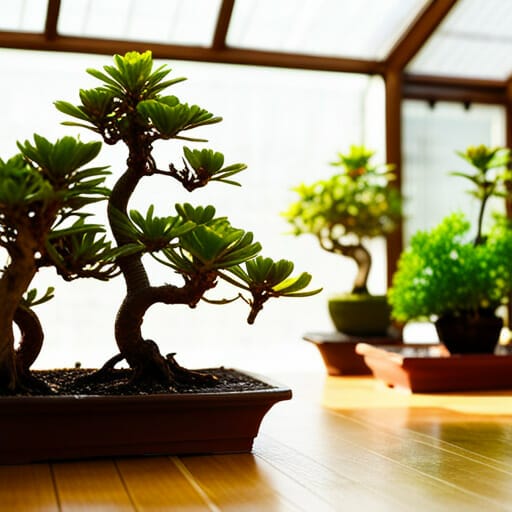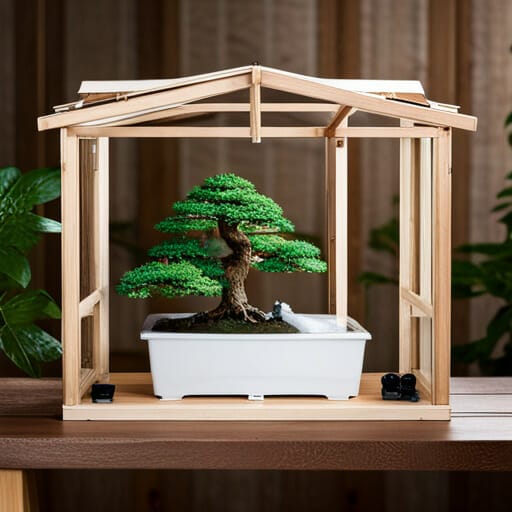Growing bonsai trees requires careful attention and protection, especially in adverse weather conditions. One way to ensure their safety and longevity is by providing them with a controlled environment in a bonsai greenhouse. While some may argue that growing bonsai trees in a greenhouse is unnecessary or excessive, the reality is that these miniature trees need utmost care and protection to thrive.
In this article, we will explore the importance of building a strong foundation for the greenhouse, choosing the right location, and maintaining proper temperature control. These elements are crucial in providing the necessary protection and care for bonsai trees. By creating a shield against sunlight, wind, storms, squirrels, and insects, the greenhouse safeguards the trees, allowing them to flourish and develop their unique characteristics.
Furthermore, growing bonsai trees in a greenhouse not only protects them but also enables enthusiasts to hone their bonsai gardening skills and foster a deeper connection with nature. The article will provide insights and practical tips for those who desire to serve these delicate trees by creating a conducive environment for their growth.
Contents
- 1 Quick Points
- 2 Building a Strong Foundation
- 3 Choosing the Right Location
- 4 Temperature Control
- 5 Frequently Asked Questions
- 5.1 What types of trees are best suited for growing in a bonsai greenhouse?
- 5.2 How often should bonsai trees be watered when grown inside a greenhouse?
- 5.3 Are there any specific pests or diseases that bonsai trees are more susceptible to when grown in a greenhouse?
- 5.4 Can bonsai trees still be pruned and shaped while being grown inside a greenhouse?
- 5.5 Are there any special considerations or techniques for fertilizing bonsai trees in a greenhouse environment?
Quick Points
- Bonsai trees require a controlled environment in a greenhouse for their safety and longevity.
- Choosing the right location with good sunlight and proper drainage is crucial for growing bonsai trees.
- Temperature control is vital for maintaining the ideal climate in a bonsai greenhouse, with roof vents and cooling fans preventing excessive heat buildup.
– A greenhouse provides protection from sunlight, wind, storms, squirrels, and insects, ensuring the well-being of bonsai trees.
Building a Strong Foundation

The foundation of the greenhouse should be constructed using materials like poured concrete or ground contact-rated wood to ensure strength and stability. These materials provide a solid base for the greenhouse structure, allowing it to withstand external forces such as wind and storms.
Additionally, a strong foundation prevents the greenhouse from shifting or tilting, which could damage the bonsai trees inside. It is important to choose materials that are durable and resistant to decay, ensuring the longevity of the greenhouse.
By investing in a strong foundation, bonsai enthusiasts can create a safe and secure environment for their trees, protecting them from potential hazards. This attention to detail and commitment to quality construction demonstrates a desire to serve and care for the bonsai trees, fostering their growth and overall well-being.
Choosing the Right Location

Selecting an appropriate site for the greenhouse is crucial to ensure favorable conditions for the cultivation of bonsai. The location plays a significant role in providing the necessary sunlight and drainage for the bonsai trees.
When choosing the right location for a bonsai greenhouse, it is important to consider the availability of good sunlight throughout the day. Bonsai trees require at least six hours of direct sunlight for healthy growth.
Additionally, the site should have proper drainage to prevent waterlogging, which can be detrimental to the bonsai’s health. It is recommended to avoid low-lying areas or places with poor drainage.
By carefully selecting a suitable location that provides optimal sunlight and drainage, bonsai enthusiasts can create an environment conducive to the growth and development of their trees, ultimately ensuring their long-term health and vitality.
Temperature Control

Temperature control is a vital aspect of maintaining the ideal climate for the optimal growth and health of bonsai trees in a greenhouse, akin to a conductor skillfully orchestrating the elements of a symphony. In a bonsai greenhouse, temperature regulation is crucial to ensure the trees’ well-being throughout the year.
During the warmer months, roof vents and cooling fans can be employed to prevent excessive heat buildup, while shade cloth provides protection from intense sunlight.
In colder seasons, electric heaters can be utilized to keep the bonsai warm. Adjusting the heater settings allows for precise temperature control, ensuring that the trees are not exposed to extreme cold.
By carefully managing the temperature inside the greenhouse, bonsai enthusiasts can create a nurturing environment that fosters the growth and development of these delicate trees, ultimately enhancing their gardening skills and deepening their connection with nature.
Frequently Asked Questions
What types of trees are best suited for growing in a bonsai greenhouse?
The types of trees best suited for growing in a bonsai greenhouse depend on various factors such as climate, light conditions, and personal preference. Some popular choices include junipers, pines, maples, and ficus.
How often should bonsai trees be watered when grown inside a greenhouse?
Bonsai trees should be watered when the top layer of soil feels slightly dry, ensuring that the water reaches the roots. The frequency of watering depends on factors such as tree species, size, climate, and greenhouse conditions.
Are there any specific pests or diseases that bonsai trees are more susceptible to when grown in a greenhouse?
Bonsai trees grown in greenhouses are susceptible to pests like aphids, scale insects, and spider mites. Diseases such as powdery mildew and root rot can also affect them. Regular monitoring, proper ventilation, and using organic pest control methods can help prevent and manage these issues.
Can bonsai trees still be pruned and shaped while being grown inside a greenhouse?
Bonsai trees can still be pruned and shaped while being grown inside a greenhouse. The controlled environment allows for precise care and maintenance, ensuring the desired shape and size of the bonsai tree.
Are there any special considerations or techniques for fertilizing bonsai trees in a greenhouse environment?
Special considerations for fertilizing bonsai trees in a greenhouse include using a well-balanced, slow-release fertilizer, adjusting the dosage based on the tree’s growth stage, and ensuring proper watering to avoid nutrient imbalances. Regular soil testing is recommended to maintain optimal nutrient levels.




